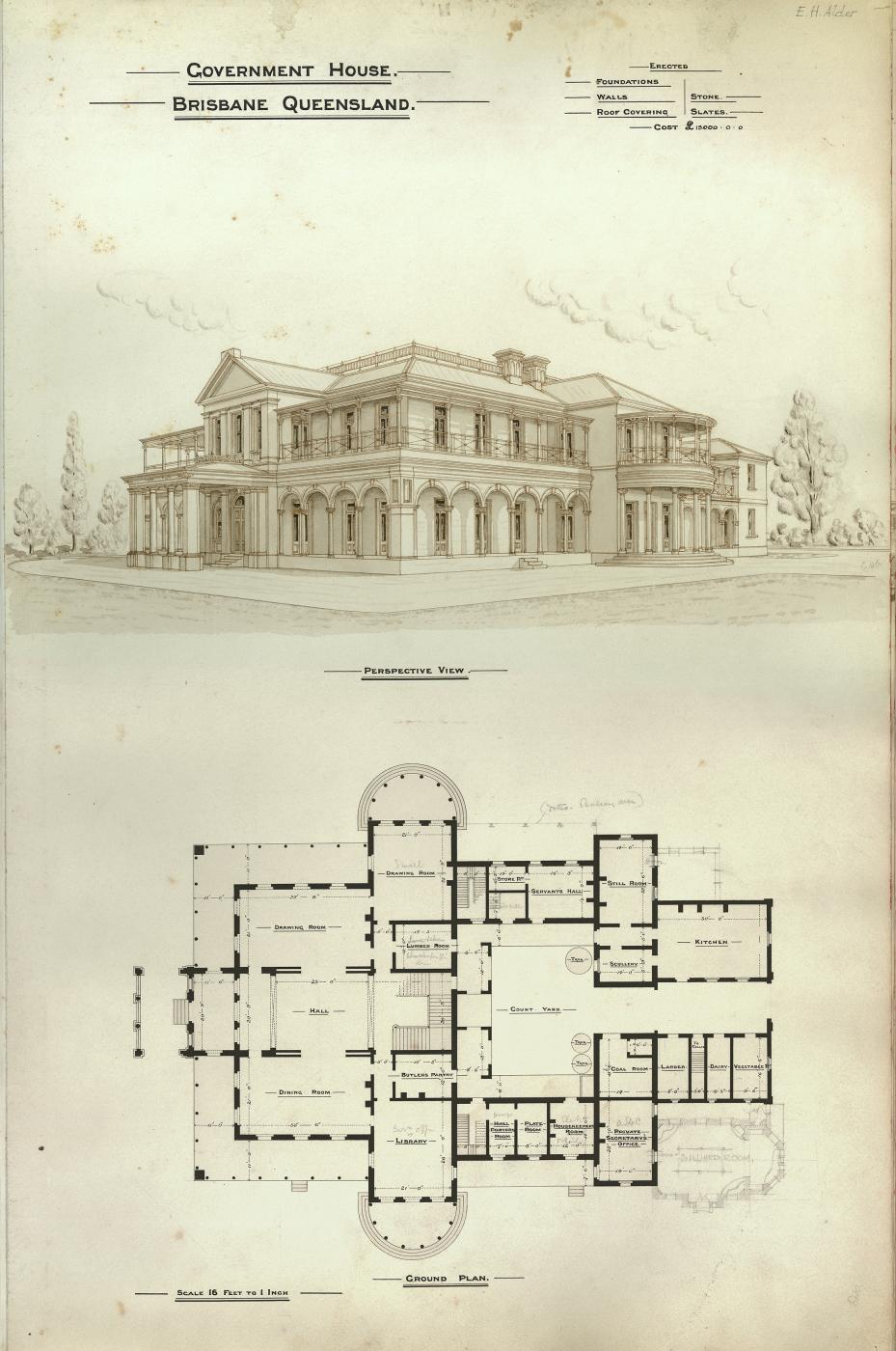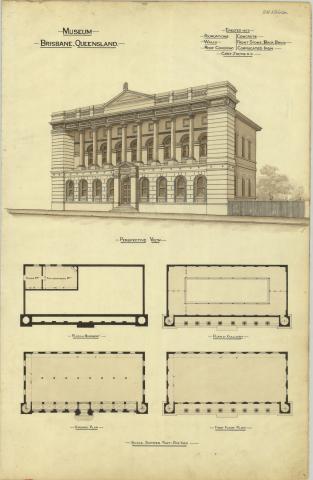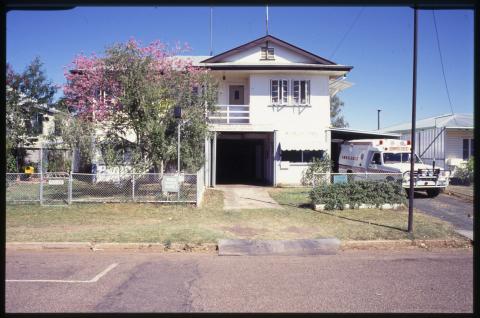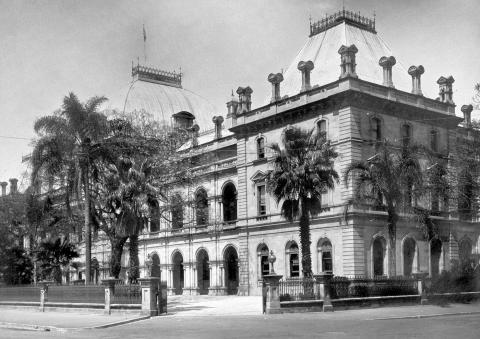
- News of the day
-
Courier, Wednesday 18 June 1862, page 2
THE BIRTHDAY BALL.
The annual ball and supper given by his Excellency the Governor, in commemoration of the Birthday of her Majesty, was postponed this year until the 16th June, in order that the prescribed period of mourning might elapse for the decease of the Prince Consort. The display on Monday night was of a description hitherto unapproached in this colony, the extent and accommodation of the suit of apartments thrown open for the occasion at Government House being such as the colony has never until the present year afforded. The last celebration of the kind was held in a building that was neither more nor less than a shed, and the accommodation was generally of a most make-shift character. At Government House, however, the liberality of Parliament has enabled the Governor to exercise his hospitality without restrictions through the want of space.
On Monday evening the three central rooms on the basement floor were given up to the dancers; the large room to the left of the entrance hall was devoted to the purpose of refreshment, where, during the evening, tea and coffee at one table, and sherry and claret at the other, were dispensed to all comers; whilst the drawing-room afforded a grateful refuge for the dowagers, as well as those ladies who were disinclined for the dance, and also contained secluded nooks for those inclined for a quiet rubber at whist.
After the Governor had undergone, with great patience and urbanity, the formality of receiving his guests, and shaken, with untiring elbow, the hands of between three and four hundred persons, the business of the evening commenced, and was kept up with great spirit until supper time. Lady Bowen was prevented by delicate health from joining in the dance, and on this account, we presume, the Governor was also merely a spectator during the evening. The ball was opened by the Colonial Secretary and Mrs. Pring, their vis-a-vis being the Attorney-General and Mrs. McDougall. The Volunteer Band, which mustered in great strength, afforded the music, the excellence of which was the general theme of conversation. Those who did not dance found an amusement in strolling from room to room, and watching the evolutions of the votaries of Terpsichore. The brilliancy of the lights, the gay and tasteful costumes of the ladies, and the sprinkling of uniforms amongst the sterner sex, in which the Consular corps, the army and navy, and the Volunteer cavalry and infantry of Brisbane and Ipswich, were all represented, presented a very pleasing coup d'oeil, such as has never before been witnessed in this colony.
Shortly after one o'clock, the Governor and Lady Bowen led their guests into the supper room, for which the quadrangle of Government House did duty, being roofed in for the occasion with canvass. The walls were tastefully ornamented with ferns and the foliage of the cabbage palm; there were also some flags, but the manner in which they were arranged was not such as called forth the admiration of the spectators. The room was well lighted both with candles and Chinese lanterns. The supper was very good, and plentiful in material, and appeared to be done full justice to. After a time, however, there was a lull in the clatter of the knives and forks, and his Excellency asked they would all fill their glasses. He had a toast to propose, which ought to be drunk in respectful silence.
The Governor then made a touching and graceful allusion to the lamented death of the Prince Consort, and to the loss the Queen and the nation had sustained through the death of that wise and prudent Prince. The toast was - "The Queen! God bless her!" Every voice in the room repeated the toast; but, as requested, no cheers followed.
Sir George then proposed - "The Prince of Wales and the rest of the Royal Family." The best aspiration of their hearts must be that the children of the Queen would tread in the steps of their parents. He believed that one or other of the Princes would shortly visit Australia, and in no colony would he be received with more cordial enthusiasm than in Queensland. This toast was received with all the honors.
The President of the Council (Colonel O'Connell) then proposed the healths of Sir George and Lady Bowen, and the toast was received with loud demonstrations of applause. After making a graceful allusion to the accomplished and courteous gentleman and the amiable lady whose guests they were that evening, he referred to the services which the Governor had rendered the colony, more especially from his energetic conduct having secured to Queensland a large increase of territory to the north-west. At the conclusion of Colonel O'Connell's remarks the toast was drunk with all the honors.
The Governor, in returning thanks, expressed his gratification at being able to receive his guests in the excellent and commodious house which the liberal loyalty of Parliament had provided for the representative of the Queen. He trusted that, so long as her Majesty would be pleased to continue his poor services in this colony, each year would be marked by an increase of mutual esteem and good-will between them.
The company then returned to the ball-room, where dancing was kept up till about four in the morning.
- Background
-
Old Government House was constructed from 1860 to 1862 to the design of Colonial Architect, Charles Tiffin at a cost of £17,000. It served as the home of the various Governors of Queensland from its completion in 1862 until 1910 when it became the inaugural of the University of Queensland.
Queensland became a separate colony in 1859, when Governor Bowen was appointed to govern until electoral roles were established. Robert Herbert was then elected as the first Colonial Secretary, a position akin to the present day Premier. In 1860 funding was allocated by the newly formed Parliament of Queensland for the construction of Government House. This was to be the first major public building which the Parliament planned.
A site was chosen for the house adjacent to the Botanic Gardens which had been established on the site of a government garden in 1855, when the curator, Walter Hill, was employed. Originally, the intention of the government was to construct a larger Government House in the country and therefore Government House was smaller than other Government Houses of Australia. It was described by the architect, Charles Tiffin, as the most economical vice regal residence in the Australian Colonies. £17,000 was allocated for the construction of the building, which was a major undertaking for a small colony of only 30, 000 settlers, facing an uncertain economical future.
Charles Tiffin was born in Newcastle, England and emigrated to the colonies in the mid 1850s, when he arrived in Victoria. He was appointed to the position of Clerk of Works for Moreton Bay in May 1857. Tiffin was responsible for the designs of a range of public buildings, the first of his major projects being the Ipswich Court House, extant in 1995. After separation, Tiffin became Queensland's first Colonial Architect.
Government House provided family accommodation, public reception areas and government offices. The house was carefully designed to take advantage of its siting on a promontory. The formal entrance and function rooms faced the river, away from the growing township; the offices were located to the north-east of the building; family quarters were on the south west and the rear north west of the building, housed servant's quarters and kitchen areas. By June 18, 1862, the Queensland Daily Guardian, reported that Governor and Lady Bowen had been in residence at Government House for one month, and that the building appears to be well adapted in point of coolness and ventilation to the climate of this colony; the rooms being large, lofty and airy, and furnished in a plain but exceedingly tasteful manner.
The house demonstrates an early understanding of ventilation principles in sub-tropical climates, in which Tiffin was known to be interested. Features of the house like the ventilated lantern, the large number of french doors, and the sliding doors on the ground floor, suggest a concern for air movement in the building.
The grounds surrounding the building were laid out by the director of the botanical Gardens, Mr Walter Hill, and it is understood that Lady Bowen also took a great interest in the gardens The grounds were thought to reflect the highest credit on Mr Walter Hill. A detailed description of the areas on each side of the house (comprised) a raised terrace, half moon and crescent shaped, neatly covered with sods of grass, and traced out in various designs for the cultivation of flowers and plants.
Governor Bowen remained at Government House until 1868, when he was recalled to England and Colonel Samuel Blackall became the new Governor of Queensland. Many alterations were made during the 1870s which saw the house adopt a more tropical form, most obviously with the addition of first floor verandahs, thereby distinguishing it from Government Houses in other states. Functions organised by the various Governors became larger to accommodate the larger population, and a prefabricated supper room/ballroom was erected on the lawn to the south west adjacent to the drawing room. In 1895, the house was completely redecorated. Old Government House was extended with a Billiard Room on the northern corner of the building in 1899.
The Federation of Australia, meant a reduction in the role of the Governor, but the real diminishing of their powers came about in around 1910 with the abolishment of the Upper House.
A committee was formed by the Premier, Mr Kidston, to select a site for a University in Queensland, and their recommendation was the Domain which was the grounds of the, then, Government House. In 1909 the House was dedicated to the new university, with five acres around it set aside for both a university and a technical college, with the remaining area given over to the Botanic Gardens. The Governor, who was then MacGregor, moved out of the house in 1910, to what were thought to be temporary arrangements at Fernberg, Paddington. By 1914, the new grounds of the University and Technical College were deemed unsuitable, and bids were made for the return of the Governor to the house, but these were unsuccessful.
Though the University transferred to St Lucia in 1945 it still retained many rooms in the former Government House. As the State Government retained the ownership of the former Government House, it was put to use by various official departments, and suffered from deterioration. In 1973 the National Trust moved into the building on the basis that they would gradually become the custodians of the entire building. Extensive alterations were carried out by the State Works Department, which again caused damage to the original fabric of the building. By 1982 the National Trust had assumed control over most of the building. The Technical College became the Queensland Institute of Technology, which in turn became the Queensland University of Technology and remains on the site surrounding Old Government House.
Courtesy of Queensland Heritage Register



